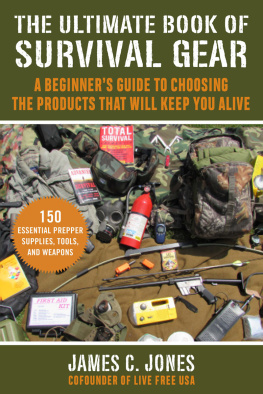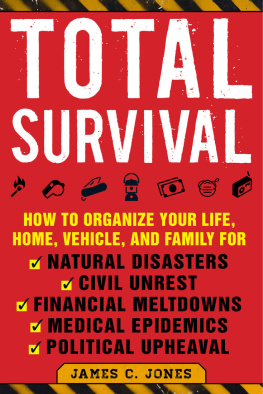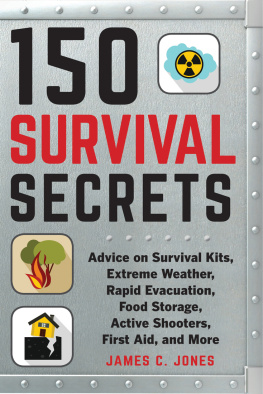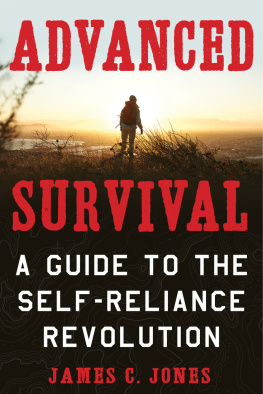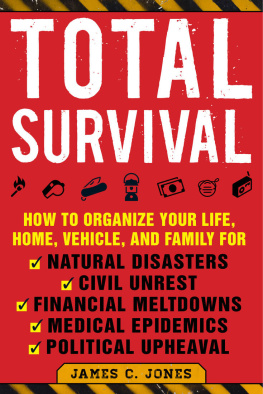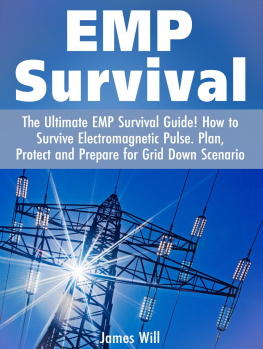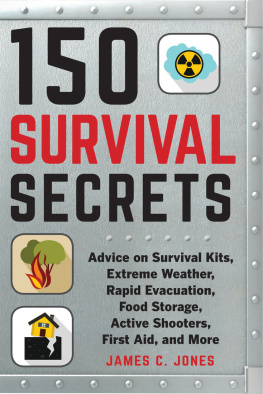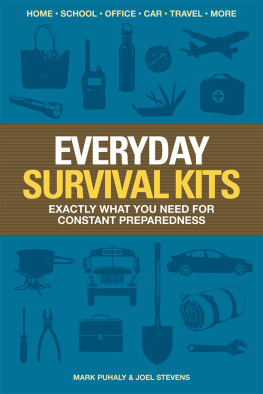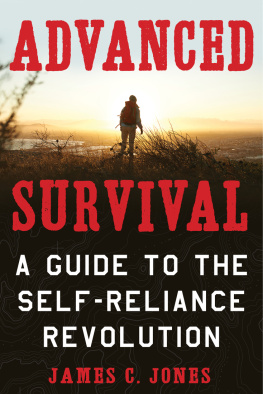James C. Jones - The Ultimate Book of Survival Gear
Here you can read online James C. Jones - The Ultimate Book of Survival Gear full text of the book (entire story) in english for free. Download pdf and epub, get meaning, cover and reviews about this ebook. year: 2021, publisher: Skyhorse, genre: Children. Description of the work, (preface) as well as reviews are available. Best literature library LitArk.com created for fans of good reading and offers a wide selection of genres:
Romance novel
Science fiction
Adventure
Detective
Science
History
Home and family
Prose
Art
Politics
Computer
Non-fiction
Religion
Business
Children
Humor
Choose a favorite category and find really read worthwhile books. Enjoy immersion in the world of imagination, feel the emotions of the characters or learn something new for yourself, make an fascinating discovery.
- Book:The Ultimate Book of Survival Gear
- Author:
- Publisher:Skyhorse
- Genre:
- Year:2021
- Rating:3 / 5
- Favourites:Add to favourites
- Your mark:
- 60
- 1
- 2
- 3
- 4
- 5
The Ultimate Book of Survival Gear: summary, description and annotation
We offer to read an annotation, description, summary or preface (depends on what the author of the book "The Ultimate Book of Survival Gear" wrote himself). If you haven't found the necessary information about the book — write in the comments, we will try to find it.
The Ultimate Book of Survival Gear — read online for free the complete book (whole text) full work
Below is the text of the book, divided by pages. System saving the place of the last page read, allows you to conveniently read the book "The Ultimate Book of Survival Gear" online for free, without having to search again every time where you left off. Put a bookmark, and you can go to the page where you finished reading at any time.
Font size:
Interval:
Bookmark:



Copyright 2021 by James C. Jones
All rights reserved. No part of this book may be reproduced in any manner without the express written consent of the publisher, except in the case of brief excerpts in critical reviews or articles. All inquiries should be addressed to Skyhorse Publishing, 307 West 36th Street, 11th Floor, New York, NY 10018.
Skyhorse Publishing books may be purchased in bulk at special discounts for sales promotion, corporate gifts, fund-raising, or educational purposes. Special editions can also be created to specifications. For details, contact the Special Sales Department, Skyhorse Publishing, 307 West 36th Street, 11th Floor, New York, NY 10018 or .
Skyhorse and Skyhorse Publishing are registered trademarks of Skyhorse Publishing, Inc., a Delaware corporation.
Visit our website at www.skyhorsepublishing.com.
10 9 8 7 6 5 4 3 2 1
Library of Congress Cataloging-in-Publication Data is available on file.
Cover design by Mona Lin
Cover photo credit: James C. Jones
Print ISBN: 978-1-5107-5309-9
Ebook ISBN: 978-1-5107-6060-8
Printed in China
This book is dedicated to our ancestors, who were all survivalists and without whose survival instincts and perseverance we would not exist today, and to our descendants to whom we owe a determination to preserve life and freedom for the future.
Table of Contents
Introduction
I n my previous books, Advanced Survival , Total Survival , and 150 Survival Secrets , I focused on the psychological and skill-based aspects of survival and emergency preparedness. This volume is dedicated to the equipment and supplies needed to survive a wide range of emergency situations. Two of the most important principles of survival relate specifically to material equipment:
Have what you need: This sounds simple, but it requires careful anticipation and awareness to have the right stuff where and when you need it. For example, having lots of food and firearms is not what you need when you have a house fire. You need good fire extinguishers! Having a full NBC suit and mask at home to protect against direct contact with a radioactive substance will not help in the more likely situation of you encountering smoke or biological hazards. Its not what you have, its what you have with you that counts. Prioritizing and acquiring skills, supplies, and equipment based on your personal and realistic expectationsrather than popular media scenariosis critical. The objective is to have safe air, effective defense, adequate shelter, clean water, sufficient food, required medical care, when and where you need it.
Use what you have : The accumulation of stuff alone will not assure survival. You have to know how to use it and then use it effectively. You will also be faced with situations where you need to improvise and scavenge. Junk and scraps can be transformed into useful items. Nature provides food, shelter, fuel, and other necessities when we do not have other options. Survival training greatly increases your options and capabilities with and without stuff. In todays world we have specially made products for every aspect of survival. This may make us complacent and dependent. A good exercise is to take every survival item you have and say what if I had to do without this, then what could I use in place of this. Know how to use it and know how to do without it, then you are a survivor!
The concept of survival gear as a category of equipment is fairly new. Prior to the late nineteenth century everything was survival stuff and a level of self-reliance and preparedness was the norm rather than the exception for most Americans. A knife, a gun, an axe, dried foods, stored water, and most of what we now consider emergency preparedness items were just normal supplies and tools. The evolution of grid-provided light, heat, water, food, protection, and emergency services, combined with the population shift to centralized urban and suburban residency, placed the majority of the population at risk and vulnerable to any large scale disaster or system failure. The wonders of technology and big city life were the dominant factors during the first half of the twenty-first century. The dawn of the nuclear age after World War II initiated the first interests in survival and having survival gear. World War II also generated the development of survival training and survival equipment for downed pilots. The civilian was left with Civil Defense recommendations that only applied to surviving a nuclear holocaust and surplus military equipment and manuals such as FM 21-76 Survival that were of marginal utility for home emergency situations. Even Be Prepared Boy Scout manuals were more about camping than disaster preparedness.
The survivalists or self-reliance practitioners of the 1950s and 1960s, had to get by with military surplus, Boy Scout items, and a lot of homemade and improvised gear. It was not until the late 1970s that we began to see a few good civilian-related survival items on the market. The increasing frequency of natural and man-made disasters, terrorist acts, and potential system failures in the past few decades has generated a market for truly useful and high-quality survival items designed specifically for civilian use. As the narrow threat of nuclear war was replaced by a broad-range of potential emergencies and disasters, the variety and availability of equipment designed to save, preserve, and defend the lives of individuals and families through even the most challenging situations has grown into a major business market. Todays responsible citizen seeking to achieve a greater capacity to survive, escape, withstand, and recover has a wide range of products from which to choose.
In 2013, the American Housing Survey conducted by the US Census Bureau determined the level of emergency preparedness of American families. The results of such surveys can be considered soft data, subject to how the respondents interpret the questions and their definitions of the wording. The survey indicated that fifty-four percent of Americans had at least twenty-four bottles of water for emergencies, whereas a bare minimum of five gallons per person is recommended. Eighty-two percent of respondents said that they had at least three days of food on hand for emergencies. In reality, most homes always have enough residual food, and leftovers for three days, but many emergencies require that at least a thirty day supply of non-perishable (canned, dried, dehydrated) foods be available. Fifty-one percent of those surveyed indicated that they had an emergency evacuation kit. How adequate these kits are or whether they had kits for every family member was not established. As the rate and severity of disasters has continued to escalate, we can hope that family preparedness levels improve.
Furthermore, existing equipment will need to be upgraded and updated to meet emerging challenges and hazards. In this book, I have provided options for those just starting their journey towards preparedness and those engaged in continuous improvement and advanced preparedness. This book explores each category of survival gear and emergency supplies with attention to their importance, functions, and options available. A variety of available products are illustrated with specifications, qualities, prices, and sources. Where possible, products of various price ranges and qualities are covered. While it is best to have only high-quality, high-end items in all these survival categories, everyone will have some budget limitations, so low-cost and surplus items are included wherever possible.
Next pageFont size:
Interval:
Bookmark:
Similar books «The Ultimate Book of Survival Gear»
Look at similar books to The Ultimate Book of Survival Gear. We have selected literature similar in name and meaning in the hope of providing readers with more options to find new, interesting, not yet read works.
Discussion, reviews of the book The Ultimate Book of Survival Gear and just readers' own opinions. Leave your comments, write what you think about the work, its meaning or the main characters. Specify what exactly you liked and what you didn't like, and why you think so.

